Initiatives
The results of renewable energy initiatives to reduce CO2 emissions are promising. Read more about them on this page. An overview of all initiatives can be found at the bottom of this page. The contributions were previously published in the periodic column 'Het Duurzame Initiatief' in De Wassenaarse Krant.
Solar panel action Neighborhood Teams
Four neighborhood teams have joined forces and set up a joint procurement process for solar panels to save energy and costs. The neighborhood teams Nieuw-Wassenaar, Park De Kieviet, Centrum and Groot Deijleroord have made good agreements with supplier Freek van Os to handle the implementation according to their wishes. Thus, in non-standard situations, there is attention and room for customization. On September 2, 2020, the first 'neighborhood panels' were installed in the presence of all parties involved. Watch the film here. For questions, please contact Mireille Soeters at telephone number 06 - 29 50 50 22.
Driving Smart Together
Since the start of Samen Slim Rijden early this year, 12 participants have now made 243 trips in the Nissan Leaf, the electric shared car. That's an average of 53 kilometers per ride and amounts to 9,600 kg less CO2 emissions than a gasoline-powered car. Anyone who wants to give it a try can request a test drive through the website . If you like it, you can drive in the shared car within a day of registering. People who have just obtained their driver's license can also sign up. There is no age limit. And of course, the more participants, the sooner there will be a second car.
Online EnergyParty
Participating in an EnergyParty shows residents the way to lower energy bills. Due to corona measures, EnergyParty parties can only be given online. Neighborhood Power has launched a recruitment campaign in Wassenaar to find 25 new hosts. The call for volunteers to host an online EnergyParty comes at a great time. Homeowners recently received a voucher, an allowance towards the cost of energy-saving resources. The voucher can be spent on small measures such as a door closer or draft strips or for a first step toward a larger investment such as solar panels or insulation. People who sign up as organizers invite around eight neighbors. During the evening the participants look together at their energy consumption and saving possibilities. A professional moderator guides the evening and provides the necessary information. Afterwards everyone has a concrete and personal action plan, no obligations. Interested? For more information visit www.buurkracht.nl/energyparty or download the app from buurkracht and sign up.
At the Oct. 15 Climate Table, Chantal van Schaik, who has extensive experience as an organizer of online EnergyParties, was a guest. You can download the presentation at the bottom of this page.
The sustainable initiative of Neighborhood Team Backershagen
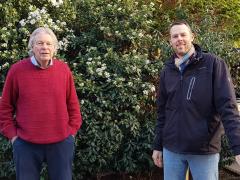
To become carbon neutral, we are working together on sustainable initiatives from the Climate Table. Meet Wassenaarders who are working on this. Like Roeland van Berckelaer and Sander ten Wolde of Buurtteam Backershagen.
What does this sustainable initiative mean to you?
On behalf of the Backershagen Neighborhood Association, we started a Neighborhood Power team because we want to do something practical for the climate. It is nice to knock on neighbors' doors because there is a feeling that you know each other. Often neighbors have a similar house. You are more likely to believe the neighbor who says solar panels save money than an advertising brochure. I noticed that among the 40 houses we scanned, many people had already taken energy-saving measures. Good news. And of course a challenge to raise the sustainability bar higher!
Why do you think this is important NOW?
Sander: I feel that with a construction education I can do something for the environment. I am genuinely concerned about the future of our environment. With engineering, I hope to be able to offer solutions to turn the tide but I also know that political organization and communication play a big role. Roeland: We all notice now that the climate is really changing: we skate less and less, we consider buying air conditioning more often. Even in politics you see that the environment is coming to the top of the agendas.
How did you guys get involved with this?
The heat camera action was in the newspaper and Roeland emailed the Neighborhood Association if anyone wanted to take this up with him. Sander was just about to do something with this, so the collaboration was quickly made! We want to organize an EnergyParty and create a model home in the neighborhood to demonstrate how to get rid of gas and still cost-effectively retrofit an older home.
What does the municipality do?
We are in a consultation group with the municipality as the Neighborhood Power Team. The municipality is working on a master plan for energy transition. Our opinion is highly valued. Perhaps this collaboration between the municipality and resident is new, so this is therefore an experiment.
What would you guys like to give Wassenaarders?
Difficult to choose from all the initiatives, groups, slogans, advertisements, labels etc. All our measures as residents (solar panels, getting rid of gas, driving electric, etc.) start with insulation. Keeping the heat or coolness in your home as long as possible. With extra insulation, you immediately notice that your home is more comfortable. And coziness in particular is worth an investment or remodel for many people.
Sander: We are still looking for a neighborhood member who is also interested in joining; please contact Sander at sandertenwolde@gmail.com
The sustainable initiative of Neighborhood Team De Paauw

To become carbon neutral, we are working together on sustainable initiatives from the Climate Table. Meet Wassenaarders who are committed to this. Like Gerd-Jan Otten, Rosita ten Berge and Pasquale van Vliet-van Dijk of Buurtteam De Paauw.
What does this initiative mean to you?
We would like to be drivers of sustainability. Our first step is to motivate the neighborhood to reduce demand (e.g. insulation). With an average gas consumption of about 3,000m3 per household (average in the Netherlands is 1,300m3), there is a lot to be gained there. This contributes to lower CO2 emissions and energy bills, more living comfort and it reduces the switch to renewable sources.
Why do you think this is important NOW?
By the end of 2021, the municipality must have a transition vision for heat ready. We can wait for this, or contribute ourselves. Pasquale: Personally, I am working a lot on sustainability. I hope to improve my own house (D label) energetically in the coming years. I am even certifying myself as an energy performance consultant. As a structural engineer, I see the challenges this presents for existing homes. But I'm happy to take on that challenge!
Gerd-Jan has been involved with sustainability both personally and professionally for a long time. In his former place of residence in The Hague, he was involved in the establishment of "DuurSaam Benoordenhout" and with his company he helps professional parties to design plans to heat neighborhoods and complexes free of natural gas. His own home also has to go, so his participation in the neighborhood team was natural.
Rosita: When I moved from The Hague to Wassenaar, it was mainly for the beautiful greenery. In order to preserve this, I like to do my bit for sustainability. I am already working (have been working) on this by buying solar panels, an electric car, participating in an Energy Party, etc. With the neighborhood teams, I hope we can reach more residents, and also provide the link to the municipality for them.
How did you guys get in touch?
Pasquale: I was alerted to the Climate Table through a flyer from the municipality. During the last Climate Table, other neighborhood teams asked for expertise in the field of insulation. I contacted them, and the ball started rolling.
What does the congregation do?
Close cooperation, and short-line communication with the municipality are desirable. The consultation of the municipality with the neighborhood teams is a good tool in this. A supported sustainability vision that matches the ideas of our and other neighborhoods is important. Residents should have a real say. We want to develop a "vision of our own" with our neighbors in the short term. Plans and ambitions should be in line with each other to complement and reinforce each other.
What would you like to give Wassenaarders?
We would like to expand our team with someone who can help us with the communication strategy and a "neighborhood anchor," someone who knows De Paauw and its residents inside out. Participate? Email: buurtteamdepaauw@gmail.com. Neighbors who have already made their homes more sustainable we would also like to get in touch with.
The sustainable initiative of Niki and Tom
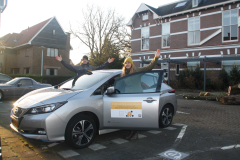
To become carbon neutral, we are working together on sustainable initiatives from the Climate Table. Meet Wassenaarders who are committed to this. Like Niki (32) and Tom (30) van Driel who are happy with the convenience offered by the electric car-sharing service Samen Slim Rijden.
What does this initiative mean to you?
It makes it financially possible for us to drive an electric car. With the shared car we drive to family, friends and sporting events. Now about once every two weeks, normally more often. One of the advantages of not owning the car is that it is not parked at the door unnecessarily. We pay according to usage; this saves costs and is better for the environment.
Why do you think this is important NOW?
We specifically chose an electric share car because of its low environmental impact. Alternative share cars are also available but they run on gasoline instead of electricity. We are quite active in the field of sustainability and would like to show that things can be done differently.
How did you come across this initiative?
Since Wassenaar has no train connection, we looked into buying a car. We came across this through De Wassenaarse krant and then planned a test drive. The ease of use and the fit with our ideas on sustainability made us decide not to buy a car, but to share. Put your money where your mouth is.
What does the congregation do?
Two charging parking spots have come up near the center and Samen Slim Rijden is on the website. Nevertheless, we believe that more can be done to support this type of sustainable initiative. For example, by encouraging or requiring developers of new construction projects to make a shared car available to residents. To break even, several participants are often needed and this is difficult to achieve in the start-up phase. Providing subsidies or contributing to promotion can help tremendously.
What would you like to give Wassenaarders?
The shared car is our only car, which we use only when public transport is not an option. Judging by the number of cars in Wassenaar, households often have more than one car at their disposal. The shared car is a perfect replacement for a second car, which is probably often parked outside the door, taking up public space that could otherwise be dedicated. Inspired? Visit https://samenslimrijden-wassenaar.nl/.
The sustainable initiative the Climate Table
From the Climate Table, residents and municipality are setting up actions to reduce CO2 emissions and protect the climate. In this column, the initiators talk about their sustainable actions using 5 questions. This time in the spotlight the Climate Table and members themselves.
What is the Climate Table?
A Wassenaar initiative in which residents, entrepreneurs, organizations and municipality find each other in actions to reduce CO2 emissions. It is a platform to get acquainted with everyone who not only wants to become more sustainable, but also has an idea of how we can realize that together. So talk and do. Examples are the Wassenaar Energy Cooperative, the electric car sharing program Samen Slim Rijden and the actions of the Neighborhood Teams. The municipality is a partner of the Climate Table and facilitates the network and the meetings.
Why is this important now?
We are at the beginning of the energy transition. In the coming decades we will move step by step to clean energy and natural gas-free heating. This is happening on an international, national, regional and local level. The road to CO2 neutrality is long and everyone will be affected sooner or later. The Climate Table shows what steps you can take today towards a sustainable future.
How did this initiative come about?
At the start in 2018, enthusiastic residents reported to the municipality with sustainable plans. There was a need for a joint network to inform, spar and inspire each other to do something concrete about CO2 emissions. And it works: we help each other sharpen plans and achieve results. We have a lot of knowledge and expertise and learn from each other. During the meetings and also outside, people know how to find each other. That networking function is very valuable.
What does the congregation do?
With the goal of reducing CO2 emissions in our municipality, the municipality facilitates resident initiatives by bringing people together so they can share their ideas and where possible support them with expertise. For example, by engaging an external party. Like Buurkracht that helps neighborhood teams realize a solar panel project and heat scans. This successful cooperation is contagious: a neighborhood team may be added. The Climate Table Newsletter is published periodically.
What does the Climate Table want to give to Wassenaarders?
Join us! Not everyone has to start their own sustainable initiative to contribute to the reduction of CO2 emissions. You can also join existing initiatives. Check the website to see which ones. You can also use the municipal schemes to save energy. Or visit the climate table meeting on Wednesday, February 17. We welcome you! Sign up via klimaattafel@wassenaar.nl. For the program and all information about the energy transition and the Climate Table check out the special sustainability page.
The sustainable initiative of the Wassenaar Energy Cooperative (WEC)
To become CO2 neutral, we are working together on sustainable initiatives from the Climate Table. Meet Wassenaarders who are committed to this. Like Edward Verschoor, Daniel van Dongen and Gerke Henkes. Five questions to the brand new board members of the WEC.
What does this sustainable initiative entail?
Edward: "The WEC is going to generate energy locally. We will start with solar panels on a roof of the municipality, a company or an institution. This will allow all Wassenaar residents to buy local green energy, even if it is not possible to install solar panels themselves. In 2021 we want to generate at least 135,000 KiloWatt hours, good for 40 average households. In the next 5 years we would like to provide more than 260 households with green power - 1 MegaWatt Peak."
Why do you think this is important NOW?
Daniel: "We are convinced that the current use of raw materials to generate energy is not future-proof. The techniques to change this are now widely available. Why get fossil energy from far away when we can generate clean energy locally? This is already happening in many communities, so the WEC can make use of a lot of existing knowledge. Next year's new PostCodeRoosRegulation, makes joint investment in solar energy interesting for everyone."
How did the initiative come about?
Gerke: "The WEC originated from the network that meets at the Municipality's Climate Table. With the neighborhood teams and Buurkracht, we first worked on the collective purchase of solar panels for private roofs. Now, with a team of 10 Wassenaarders, we continue to work on the larger roof areas. Together local sustainability is paramount."
What does the congregation do?
Daniel: "WEC and the municipality are jointly drawing up a letter of intent. These mutual agreements focus on the accelerated rollout of sustainable energy through citizen participation. The municipality is also helping us in our search for large roofs: this way we can start generating Energy for both the roof owners and the residents of Wassenaar."
What do you want to give to Wassenaarders?
Edward: The WEC was founded for Wassenaarders and by Wassenaarders. In this way, as an international village, we are also working locally on the Paris climate agreement. That's why we are calling on people to become members of our cooperative. With a first group of members we want to put the first roof into use as soon as possible. How that works? We explain it on the website www.WEC-duurzaam.nl.
The sustainable initiative of Neighborhood Team Groot Deijleroord
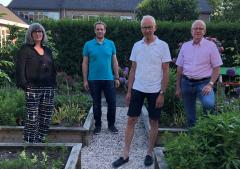
To become CO2 neutral, we are working together on sustainable initiatives from the Climate Table. Meet Wassenaarders who are committed to this, such as Annelies Heijl, Kees van der Kroft and Yuri Nieuwenhuizen of neighborhood team Groot Deijleroord and the chairman of the neighborhood association, Nico van Egmond.
What does this initiative entail?
Like so many people, there are many residents in our neighborhood who have plans to make their homes more sustainable, but in practice it does not always happen. By working together and joining forces we were able to set up a solar panel campaign together with 3 other Wassenaar neighborhoods. Subsequently, last winter we visited local residents with heat cameras to gain insight into where there is heat loss from the house. Now we are preparing an action to insulate homes. And who knows, maybe we will take up another project to make the neighborhood more beautiful and sustainable.
Why do you feel it is important to engage in this NOW?
Annelies: global warming has been on my mind for a long time and I think it is important to do my part. There are now solar panels on my roof. Besides solar panels on the roof and shed, Yuri has insulated his house in such a way that he no longer needs gas for heating. "Last winter it turned out that a heat pump is sufficient. The knowledge I have gained I would like to make available to the neighborhood."
How did you get started?
As a regular visitor to the Climate Table, Kees saw the survey that was circulated among residents in the Kieviet: we took that survey as a basis in Deijleroord. Initially we wrote to about 250 fellow residents and then our team came into being. We now work intensively with five other neighborhood teams, which is not only efficient but also very inspiring. Chairman Nico van Egmond of the neighborhood association adds that he supports the initiatives and offers the Deijlerhuis as a location to organize meetings (after Corona!!) to present insulation options and other sustainability initiatives.
What does the congregation do?
Kees: The municipality helps us by providing substantive support through Duurzaam Bouwloket, in addition we can use the communication tools of Buurkracht. That helps us enormously because it's all voluntary work.
What would you like to give Wassenaarders?
Yuri: Regardless of what drives you: the climate, CO2, sea level rise or your own wallet: being frugal with resources and thus with energy is always good for something. A well-insulated house also provides more comfort.
Have we piqued your interest and would you also like to contribute to neighborhood initiatives? Email zondeijleroord@kpnmail .nl and we are guaranteed to contact you!
The sustainable initiative of Stefan Bruinings
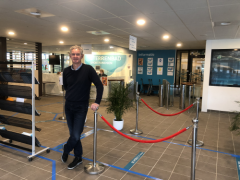
To become carbon neutral, we are working together on sustainable initiatives in the Climate Table. Meet the Wassenaarders who are working towards this. Like Stefan Bruinings, manager of the Sterrenbad swimming pool. Five questions to this initiator.
What are you doing about sustainability?
Both roofs are now sustainable, one has been a sedum roof for 11 years, the other is going to provide solar power. We also have LED lighting almost everywhere and soon energy-efficient pumps. We also ban disposable plastic: plastic straws, PET bottles, we replace everything with biodegradable and therefore recyclable material.
How did the idea come about?
A swimming pool is a special building with high costs for water, fuel (gas) and electricity. Sustainability has increasingly come to the fore during years of pleasant mutual contacts between owner, municipality, operator and Sportfondsen.
Why do you think this is important NOW?
The real origin lies with my children, aged 26 and 28, who show me more and more how important it is to them that we make steps now in themes of nature, sustainability, improvement and or tapping into other new sources of energy.
What does the congregation do?
As a discussion partner, the municipality is putting time, energy and knowledge into this. The financing for the solar panels has been made available/transferred to Sportfondsen Wassenaar BV. There is willingness to extend the cooperation, credit to both organizations of which we are proud.
What do you want to give to Wassenaarders?
As host of the Climate Table, I have seen how support is given to initiators. I don't have to give these Wassenaar citizens anything but encouragement: Keep it up! And feel welcome in your beautiful pool and also work on your own sustainability and vitality!
The sustainable initiative of Neighborhood Team South
To become carbon neutral, we are working together on sustainable initiatives from the Climate Table. Meet Wassenaarders who are committed to this. Like Geert Ensing, Madelon Moorlag, Sven Kramer, Susanne van Eps and Mireille Soeters of the neighborhood power team Wassenaar-South.

What does this sustainable initiative entail?
Mireille: Our first big action was promoting solar panels with the Groot Deijleroord, Centrum and De Kieviet neighborhood teams. By distributing leaflets, notifications in the neighborhood apps and an online presentation, we got neighbors on board. At the same time, we approached the market. Based on quality, warranty, safe work and price, we chose the Firma Freek van Os as our installer and developed a quotation process with him. Already 200 quotations have been requested, 58 executed, more than 300 solar panels installed, totaling more than 110,000 Watt peak!
Why do you think this is important NOW?
Geert: Energy transition is now gaining momentum because concrete steps are possible. I had been thinking about solar panels for a while; the neighborhood initiative was exactly the push I needed. It was inspiring to work on this with a team, which was reinforced when we started working together with other neighborhood teams. When you take actions together, the impact is much greater than individually.
How did the initiative come about?
Mireille: During a New Year's reception, I got into a conversation with Sven about the need to become more sustainable and to take the lead in this ourselves. He and Susanne already had solar panels but wanted to enthuse more residents to generate their own electricity. Before I knew it, I was on the team. We sent out a neighborhood survey. This showed that most interest was in solar panels.
What does the congregation do?
Madelon: The municipality hired Buurkracht, which got our sustainability project off to a flying start. When in doubt or unclear, we were immediately motivated and helped on our way. The support with the help of the neighbourhood power app and other communication tools is super efficient. Because you are well supported, know how to find each other and complete a first project, the conviction grows that you can very well take up sustainable initiatives with the
neighborhood. And we do!
What do you want to give to Wassenaarders?
Susanne: Just start. With the panels we have saved so much money at home that we are going for a second round and joining this solar panel campaign. One of the best investments with a high guaranteed return still remains completely filling your roof with solar panels. And tip for the holidays: watch the documentaries Before the Flood, Cowspiracy or Normal Is Over 1.1. and get inspired!
The sustainable initiative of The Green Meent
From the Climate Table, we are working together on sustainable initiatives. Meet Wassenaarders who are committed to this. Like the volunteers of De Groene Meent.
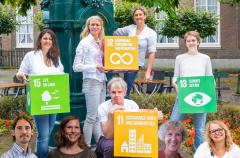
What does The Green Meent entail?
The Green Meent is a resident initiative of ten regular volunteers. We show how to live a more conscious, sustainable life. We like to do "GREEN DOING" with all residents: together we achieve more. By collaborating on sustainability with other groups and organizations, we hope to inspire and show more and more people that a sustainable lifestyle does not have to be very complicated. We do this with various actions. On the website of De Groene Meent you can see exactly which ones.
Why do you feel it is important to engage in this NOW?
Because tomorrow is too late. Together, more biodiversity, less waste and contribute to less CO2 emissions. This can be done with much more than just "getting off the gas. There are simple steps you can take. And once you start....
We come up with different actions that also appeal to different people all the time. And so the collective grows. So here's a call to join the waste diet, the collective purchase of green sedum roofs, the clothing knapsacks, and/or Trash&Treasures. Think Global, Act Local.
How did you get started?
In October 2019, the film "Normal is over" was at the library. Afterwards, you could ask director Renée Scheltema questions. Afterwards, some people stuck around. With that group, we got together and that led to the first activity: Recycle Sint. Since then we have moved on to so many projects; some come back annually, others are ongoing.
What does the congregation do?
Wassenaar is one of the 105 GlobalGoals Municipalities in the Netherlands. The municipality thus indicates that it wants to actively cooperate to actually achieve the 17 GlobalGoals in 2030. These 17 GlobalGoals are also our starting point. In some actions we cooperate with the municipality. The first year we got a starting subsidy from the municipality, now we get it from Fonds Wassenaar. We are happy with that!
What would you like to give Wassenaarders?
Just by modifying your behavior, there are gains to be made. Sustainability does not have to be 'expensive'. On our website you can see which activities you can join or submit your own initiative. Or drop by: soon you will be able to do so in the library. Together we keep our Meent Green.